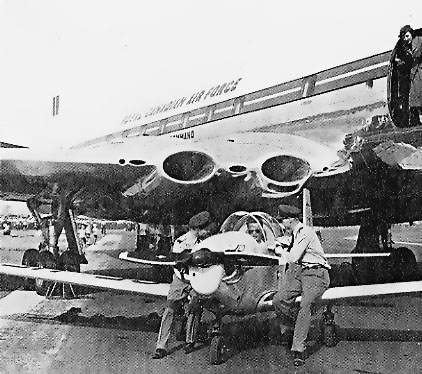
Flying the Wee Scotsman
This excellent article by Robert G. Halford first appeared in the November 1953 issue of AIRCRAFT Magazine. For those who will never fly a Mooney Mite, this description and flight report is about as close as you can get.
THIS ONE goes like a bomb, as they say in the native patois. A few weeks ago we had the rather unique experience of flying the Mooney M-18C "Wee Scotsman," a tiny airplane that has only recently become generally available in Canada. While the Wee Scotsman has the normal quota of shortcomings commonly associated with small airplanes, its very smallness makes it unique, and this uniqueness overshadows any of the disadvantages of small size.
We flew the M-18C at the invitation of the Canadian distributor, Frank Ogden of Toronto, who took on the franchise as a sideline to his regular work as advertising & sales manager for Ekco Products Co. (Canada) Limited (kitchenware). In the latter capacity, Mr. Ogden has met with considerable success through the use of razzle-dazzle selling methods and, inspired by this success, he is applying the same methods to the selling of airplanes.
 |
How many airplanes will be sold in this manner remains to be seen, but there is little doubt that as a result of Frank Ogden's promotional work, the Wee Scotsman is the most publicized personal airplane ever to come to Canada. There have been stories and photographs in newspapers and magazines coast-to-coast and it has been featured or mentioned on a number of radio programs. The airplane, which just naturally lends itself to this sort of thing, has been displayed in super-markets. where it has been offered for sale at six dollars a pound (a number of spare parts were kept on hand in case a wiseacre asked for one pound).
It has appeared at a number of air shows, including Montreal's Aviation Week. where it was flown by members of the crew of one of the RCAF's Comets. Mr. Ogden even tried to get two Wee Scotsmen flown competitively in the Governor General Trophy Race at the recent National Air Show by Jacqueline Auriol of France and Jaqueline Cochran of the U.S. Unsuccessful though this try was, it still made the papers.
Not New: The Wee Scotsman is by no means a new airplane. It has, in fact, been in production since 1946, when Charles G. Yankey and Al Mooney, two Culver Aircraft Corporation expatriates, established Mooney Aircraft Incorporated, at Wichita, Kansas. By January, 1953, Mooney had turned out over 200 M-18 "Mites" (at first powered by a modified Crosley Cobra engine of 25 hp.), as the Wee Scotsman was originally known. At that time, production was suspended while Mooney moved to Kerrville, Texas, a shift prompted by the high cost of the Wichita labor market. By April, production of the M-18 was resumed and the name changed to "Wee Scotsman". Besides turning out large numbers of this airplane, Mooney has completed and flown within the last few weeks the prototype M-20 "Scotsman", a four-place personal-type aircraft that looks just like a scaled up M-18.
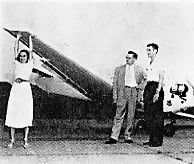 Carol Ogden shows just how light the Wee Scotsman is. Watching her are her husband Frank Ogden and Mooney test pilot and chief inspector, Dick Golembeski. Actual empty weight is 540 pounds. Gross weight is 850 pounds. Selling price in Canada is $3,195 with standard equipment.
Carol Ogden shows just how light the Wee Scotsman is. Watching her are her husband Frank Ogden and Mooney test pilot and chief inspector, Dick Golembeski. Actual empty weight is 540 pounds. Gross weight is 850 pounds. Selling price in Canada is $3,195 with standard equipment.
We originally saw and inspected Frank Ogden's demonstration M-18C, CF-HFN, some weeks before actually flying it. At the time of this initial inspection we were given a cockpit check by Mooney Chief Inspector & Test Pilot Dick Golembeski, who had ferried the aircraft to Canada.
Naturally, the first impression one gets of the M-18C is one of extreme smallness. This is not surprising, since the aircraft has an empty weight (standard equipment) of just 540 pounds. Its overall height is not much over six feet, so that when it is in the normal level attitude, the cockpit canopy is well below shoulder level.
Getting In: The canopy slides back by means of rollers on rails and access to the cockpit is gained by climbing up on the leading edge of the wing, facing forward and then stepping into the cockpit in approximately the same manner as you get into a canoe from a low dock. The cockpit is unexpectedly roomy and should not cramp the long distance pilot any more than he now gets cramped by any of the popular makes of two-place aircraft. The layout is stark in its simplicity; a vernier-type throttle (not standard) is at the extreme left of the panel while the standard instruments include airspeed indicator, magnetic compass, tachometer oil temperature, oil pressure.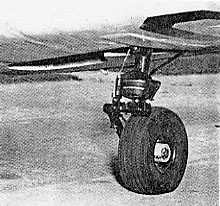
At left is a close-up of a main undercarriage leg. Note rubber discs for shock absorption.
The fuel gauge is simply a sight feed glass (made of plastic) mounted on the bulkhead behind and to the right of the pilot's head. To get a fuel reading. the pilot need only turn his head slightly to the right. Behind the bulkhead is mounted the main fuel tank, a 16-gallon unit which may be augmented by an optional six gallon auxiliary tank located in the wing. The latter is pumped into the main tank by means of a simple wobble pump arrangement (on the left side of the cockpit) when the fuel level in the main tank falls below six gallons.
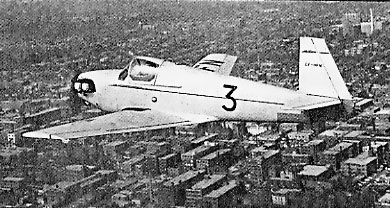 Wee Scotsman is no longer available in Lycoming-powered version, all production now being powered by Continentals. Wee Scotsman is no longer available in Lycoming-powered version, all production now being powered by Continentals. |
Also mounted on the left sidewall is the combined trim and flap control. Adjustment of trim and movement of flap is effected through a crank driving a worm which turns a screw, in turn moving an actuating rod. Trim is applied by means of an adjustable stabilizer and only after full nose-up trim is reached do the flaps go down. As far as the pilot is concerned, all he must do is turn the crank until it comes up against its stop, at which point the airplane is trimmed for maximum tail heaviness and the flaps are at maximum depression of approximately 16° (less flap can be applied it desired), An additional trim adjustment is located just below the trim crank. This takes the form of a two position selector unit marked "Up" and "Down". Normally this is left in the "Up" position, but when the baggage compartment is loaded (it takes up to 75 pounds), the selector is moved to the "Down" position. This compensates for the rearward CG movement occasioned by the additional weight behind the pilot-since the baggage compartment is located just below the main fuel tank.
Gear Retraction: At the right side of the cockpit is the undercarriage retraction lever. When the undercarriage is down and locked, this lever is in a perpendicular position and to reach it, the pilot reaches under and behind the instrument panel: an inspection hole cut in the panel enables him to see lever and to check that it is locked in position. This actuating lever is fitted with a spring-loaded sliding shouldered handle that, when fully extended, fits into a corresponding hole drilled in a metal block mounted on a fuselage member. To raise the undercarriage, the pilot merely pulls the handle down, thus freeing the actuating lever, which he pulls back through an arc of about 90°. It is locked in the retracted position by the same means as described for the extended position. Naturally, to put the undercarriage down, the pilot merely reverses the procedure for retraction. The linkage with the two main legs and the nose leg is a straight mechanical one, with the main legs retracting inwards and the nose leg rearwards.
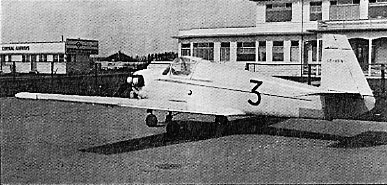 |
An interesting feature is the undercarriage warning, which is nothing but an adaption of a standard Trico automotive-type vacuum-operated windshield wiper. This unit is mounted at the top of the panel, but it is fitted with a red disc in place of a wiper blade. When the throttle is closed, this Trico unit begins to wig-wag frantically, keeping in motion until such time as the undercarriage is lowered.
Such ingenious, simple, and consequently cheap devices are typical of the Wee Scotsman. Another example of the designed-in economy of this airplane is the use of ordinary industrial truck wheels: all three take easily obtainable 4.00 x 4 tires and are fitted with internally expanding automotive type brakes (about which, more later). Shock absorption is provided by means of a special rebound-controlled assembly of rubber discs which position the wheel mounting spindles. This eliminates air and oil struts.
The flying controls are operated by a conventional stick and rudder pedal combination. Individually operated toe brakes are fitted to the rudder pedals, which also impart change of direction to the steerable nose wheel.
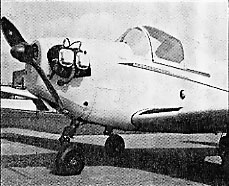 |
Structure: Conventional methods of construction are followed, though this includes three general classes. The structure surrounding the cockpit and supporting the engine is welded steel tubing skinned with dural sheet while the rear fuselage is of wood and plywood, as is the wing. The wing is a one piece fabric-covered unit featuring a single spar structure employing a thick-skinned torsion-box leading edge. Empennage and control surfaces are of steel tubing covered with fabric. The entire airplane is finished with a flame-resistant plastic butyrate finish called "Tex-hyde."
Power comes from a Continental A65-8 engine developing 65 hp for take-off. A fixed pitch propeller is standard equipment, but a manually controlled variable pitch Flottorp, Model R000 may be fitted at extra cost. Frank Ogden's machine has the standard propeller.
A STARTER is not standard equipment, so the person swinging the prop stands behind it, facing forward. In this way, if the aircraft moves forward, he simply sits down on the leading edge of the wing. We mentioned this because in our own case the airplane did actually lurch ahead with the first burst of power, and Frank Ogden, who swung the prop for us, did actually sit on the wing. At this time, we credited this movement with our own failure to apply the brakes properly.
Once the engine settled down we proceeded to taxi out to Runway 6 on Toronto's Island Airport. The Wee Scotsman taxis smoothly and easily. Probably because we were taxiing downwind in a stiff breeze, we found it necessary to brake frequently to keep our speed from getting out of hand. It was at this point that we began to suspect that the brakes were not all they might be. Possibly they were merely in need of adjustment, or our application was improper, but we had to use considerable force before they took effect. Ground maneouvering characteristics are otherwise excellent, and in spite of a nasty wind, we experienced no taxiing difficulties. The outstanding visibility is of great assistance on the ground, as it is in the air.
We selected a point off the end of the active runway and proceeded with the preflight check. This included the customary engine run-up to full throttle, and in doing this we once again experienced brake trouble, being unable to hold position as the engine neared maximum rpm. It was necessary to do a mag check by ear because the tachometer cable on CF-HFN had broken the day previously and there had been no time to get it replaced.
The Weather: At this point it should be mentioned that the weather was by no means ideal for carrying out a check flight on a strange ultra light aircraft. The wind was from the east at 25 mph, gusting to 35. This meant that there was a crosswind of approximately 30°. Ceiling was about 3,000 feet and visibility, ten miles; temperature, 60°F. We estimated gross weight at time of take-off at 770 pounds.
We lined up on the runway and opened the throttle to maximum power. The Wee Scotsman accelerates quickly and there is an initial tendency to over-control on take-off, which probably explains why the rudder pedals are substantially spring-loaded The airplane broke ground at approximately 50 mph IAS and in a distance of less than 150 feet; a gust lifted the right wing and in bringing it back down to level position again we quickly became aware of the Wee Scotsman's exceptional performance in the rolling plane. The ailerons are beautifully light and respond with gratifying briskness.
We were able to get the undercarriage up much more promptly than we had expected to do it the first time. In truth, we had anticipated experiencing some awkward moments, our feeling being that as we leaned forward to reach for the retraction lever with our right hand, we might unintentionally push the control column ahead. However, these fears were unfounded. The average pilot, after two or three take-offs, should be able to acquire considerable dexterity in snapping the gear up smartly.
The Climb: Recommended climbing speed is 80 mph, at which Mooney claims a rate of climb of over 1,000 fpm at sea level. Even though we climbed at a speed about 10 mph greater than that recommended, we had passed the 750 foot mark before passing over the airport boundary. If anything, Mooney's figure is on the modest side. We climbed at full throttle which gives, according to engine data, 2300 rpm. As noted, we did not have a tachometer with which to confirm this.
An altitude of 3,000 feet was selected for a cruising performance check, something that was rather difficult to do accurately owing to the lack of an engine speed indicator. However, we throttled back slightly and trimmed for level flight. When the airplane had settled down as much as possible in the somewhat turbulent air, the airspeed indicator gave a reading of 120-125 mph, bearing out Mooney's published optimum cruising speed of 130 mph @ 10,000 feet. Normal recommended cruising rpm for the Continental engine are 2150.
The power-off stall (clean) is nothing to cause anxiety. There is just a trace of a shudder, then the right wing dips almost imperceptibly. Even at this point there is ample aileron control and the wing can be picked up easily. The stall breaks at 42 mph IAS, when the nose falls gently. If the stick is held full back, the aircraft descends in a level attitude, alternately dipping its nose below the horizon and shuddering gently.
Side to Side: We tried a number of vertical turns, rolling rapidly from one extreme to the other. The Wee Scotsman hangs right on without making any special demands on the pilot. The controls are nicely harmonized, except that the rudder is, perhaps, a little heavy at the falling speeds following round-out.
The approach is made at 80 mph (the undercarriage is lowered on the downwind leg at something below 100 mph). We used a trickle of power and crabbed in at a rather alarming angle. However, in spite of the crosswind and intermittent gusts, the little airplane sat down nicely, touching its main wheels just a moment before the nose-wheel came down. There was practically no landing roll and it was not necessary to resort to brakes.
We had originally chosen the runway to fly from because we did not think the tricycle gear and comparatively small wheels would be suitable for turf operations. This opinion was quickly changed by Frank Ogden who, after our flight, demonstrated that the Wee Scotsman is by no means strictly a runway airplane.
Mooney has met with considerable success in selling this airplane as a businessman's machine, unlikely as this at first seems. We would think that it should also have considerable appeal to not only the private owner, but commercial schools and clubs as well. Its low initial cost of $3,195 (including all Canadian Federal duties and taxes) and low direct operating cost of less than $2.60 per hour on the basis of 600 hours operation per year should make it especially attractive to schools and clubs. On this same basis, the per air mile rate works out to approximately .021 cents. We would think the solo student pilot's mouth would water at the sight of the Wee Scotsman (as it does any pilot, for that matter), and if this airplane can't lure them into the air, then nothing can.
CF-HFN was imported into Canada in 1953. Like many Mites, it had a large number of owners over the years. By 1957, it was owned by S. Cowley of Port Credit, ON, in 1960 by William Sikma of Hamilton, ON and in 1962 by Frank Pratten of Ottawa who sold to Donald R. Blois of Aylmer East, Quebec in 1963. The rest of the history of this Mite is outlined on our Articles page, along with several other Canadian Mites.
In 1953 Frank Ogden established the Canadian light plane altitude record by flying a Mooney M-18 Scotsman to an altitude of 19,400 feet. With a conventional internal combustion engine, he set this "impossible" record by flying up until he ran out of gas and then gliding back. That record remains unbroken.
Last updated on June 6, 2001